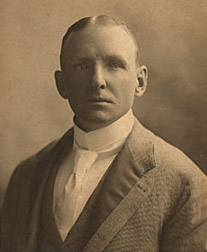Cap Anson
[2] He spent most of his career with the Chicago Cubs franchise (then known as the "White Stockings" and later the "Colts"), serving as the club's manager, first baseman and, later in his tenure, minority owner.
He ran several enterprises in Chicago, including opening a billiards and bowling hall and running a semi-professional baseball team he dubbed "Anson's Colts".
[2][3] Beginning in 1866, he spent two years at the high-school age boarding school of the University of Notre Dame after being sent there by his father in hopes of curtailing his mischievousness.
His numbers declined slightly in 1874 and 1875, but he was still good enough that Chicago White Stockings secretary-turned-president William Hulbert sought him to improve his club for the 1876 season.
His new role led to the nickname "Cap",[3] though newspapers typically called him by the more formal "Captain Anson" or "Capt.
They were helped to the titles using new managerial tactics, including the use of a third-base coach, having one fielder back up another, signaling batters, and the rotation of two star pitchers.
Anson shares credit as an innovator of modern spring training along with the president of the Chicago club, Albert Spalding.
They were among the first to send their clubs to warmer climates in the South to prepare for the season, beginning in Hot Springs, Arkansas, in 1886.
Anson signed a ten-year contract in 1888 to manage the White Stockings (which, because of a typographical error he failed to spot, ended after the 1897 season instead of 1898),[2][15] but his best years were behind him.
As the end of the 1880s approached, the club had begun trading away its stars in favor of young players, with the exception of the veteran Anson.
"[3] On August 10, 1883, Anson refused to play an exhibition game against the Toledo Blue Stockings because their catcher, Moses Fleetwood Walker, was black.
Moreover, International League owners had voted 6-to-4 at a 10 a.m. to 1 p.m. meeting in Buffalo on the morning of the game to exclude African-American players from future contracts.
[22] Anson was authoritarian as a manager, marching his players onto the field in military formation and banning alcohol consumption during the playing season.
"[24] A chronological review of 162 reports of bets on regular season baseball by players, managers or club officials, from 1876 to 1900, tallied the sport's top bettors in that era as follows: Anson first met Albert Spalding while both were players; Spalding was a pitcher for the Rockford Forest Citys, Anson played for the Marshalltown, Iowa, team.
[13][15] In 1888 Spalding announced that the White Stockings, including Anson, and a "picked nine"[13] from the rest of the National League would begin a World Tour after the end of the season.
[13] After Spalding stepped down as president of the Chicago club in 1891, he appointed James Hart to the position,[15] which Anson felt should have been his despite his dismal business record.
[13] Things remained in limbo until January 29, 1898 when the Associated Press printed a statement by Spalding: "I have taken pains as a mediator to find out from Chicagoans how they feel about a change of management.
When the first edition of Macmillan's Baseball Encyclopedia was published in 1969, it disregarded a rule in place only for the 1887 season which counted base-on-balls (walks) as hits and at-bats instead of zeroes in both categories as they were before and have been since.
[28] Other sources credit Anson with a different number of hits, largely because scoring and record keeping was haphazard in baseball until well into the 20th century.
[29] Beginning with the publication of the Baseball Encyclopedia, statisticians have continually found errors and have adjusted career totals accordingly.
According to the Sporting News baseball record book, which does not take National Association statistics into account, Anson had 3,012 hits over his career.
[10] The National Baseball Hall of Fame, which uses statistics verified by the Elias Sports Bureau, credits Anson with 3,081 hits.
[13][3] However, at the first sign of trouble he dissolved the league before a single game was played, drawing heated criticism from other backers.
[13][3] After a number of failed business attempts, including a handball arena and bottled ginger beer that exploded on store shelves,[13] he was later elected city clerk of Chicago in 1905.
[13] Anson's few successful ventures included a combination billiards hall and a bowling alley he opened in downtown Chicago in 1899.
[2] Anson was forced to sell the billiards hall in 1909 when faced with mounting financial problems that led to his bankruptcy.
Right after it was published, Cary told the St. Louis Post-Dispatch, "I really thought when I started that the ‘Cap’ [sic] would be able to reel off the story of his life about as fast as a nimble man would care to write it.
In 1888, he made his stage debut with a single appearance in Hoyt's play A Parlor Match at the Theatre Comique in Harlem.
[26][35] Later, Anson began touring on the vaudeville circuit, a common practice for athletes of the time,[35] which lasted up until about a year before his death.
[13] Anson appeared with two of his grown daughters, Adele and Dorothy, and would bat papier-mâché baseballs made by Albert Spalding into the audience.





